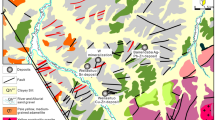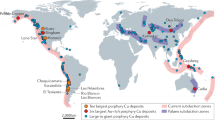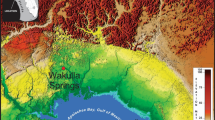Abstract
Porphyry copper–molybdenum–gold deposits are the most important metal resources formed by hydrothermal processes associated with magmatism. It remains controversial, however, whether the metal content of porphyry-style and other magmatic–hydrothermal deposits is dominantly controlled by metal partitioning between magma and an exsolving magmatic fluid phase1,2 or by scavenging of metals from solid upper-crustal rocks by surface-derived fluids3. It also remains unknown to what degree the metal content in such deposits is affected by selective mineral precipitation from the ore fluid. Extremely saline fluids4, precipitating quartz and ore minerals in veins have been inferred to have a significant magma-derived component, on the basis of geological5, isotopic6,7 and experimental evidence8,9. Here we report gold and copper concentrations of single fluid inclusions in quartz, determined by laser-ablation inductively coupled plasma mass spectrometry. The results show that the Au/Cu ratio of primary high-temperature brines is identical to the bulk Au/Cu ratio in two of the world's largest copper–gold ore bodies. This indicates that the bulk metal budget of such deposits is primarily controlled by the composition of the incoming fluid, which is, in turn, likely to be controlled by the crystallization process in an underlying magma chamber.
This is a preview of subscription content, access via your institution
Access options
Subscribe to this journal
Receive 51 print issues and online access
$199.00 per year
only $3.90 per issue
Buy this article
- Purchase on Springer Link
- Instant access to full article PDF
Prices may be subject to local taxes which are calculated during checkout


Similar content being viewed by others
References
Candela, P. A. Rev. Econ. Geol. 4, 203–221 (1989).
Cline, J. S. & Bodnar, R. J. Can economic porphyry copper mineralization be generated by a typical calc-alkaline melt? J. Geophys. Res. 96, 8113–8126 (1991).
Sheets, R. W., Nesbitt, B. E. & Muehlenbachs, K. Meteoric water component in magmatic fluids from porphyry copper mineralization, Babine Lake area, British Columbia. Geology 24, 1091–1094 (1996).
Roedder, E. Fluid Inclusions(Mineralogical Soc. of America, 1984).
Hedenquist, J. W. & Lowenstern, J. B. The role of magmas in the formation of hydrothermal ore deposits. Nature 370, 519–527 (1994).
Sheppard, S. M. F., Nielsen, R. L. & Taylor, H. P. J. Hydrogen and oxygen isotope ratios in minerals from porphyry copper deposits. Econ. Geol. 66, 515–542 (1971).
Sheppard, S. M. F., Nielson, R. L. & Taylor, H. P. J. Oxygen and hydrogen ratios of clay minerals from porphyry copper deposits. Econ. Geol. 64, 755–777 (1969).
Hemley, J. J., Cygan, G. L., Fein, J. B., Robinson, G. R. & D'Angelo, W. M. Hydrothermal ore-forming processes in the light of studies in rock-buffered systems: I. Iron-copper-zinc-lead sulfide solubility relations. Econ. Geol. 87, 1–22 (1992).
Seward, T. M. & Barnes, H. L. in Geochemistry of Hydrothermal Ore Deposits3rd edn (ed. Barnes, H. L.) 435–486 (Wiley, New York, 1997).
Taylor, S. R. & McLennan, S. M. The Continental Crust: its Composition and Evolution(Blackwell Scientific, Oxford, 1985).
McDonald, G. D. & Arnold, L. C. Geological and geochemical zoning of the Grasberg igneous complex, Irian Jaya, Indonesia. J. Geochem. Explor. 50, 143–178 (1994).
Ulrich, T. in Actas X Congreso Latinoamericano de Geologia and VI Congreso Nacional de Geologia Economica 239 (Universidad de Buenos Aires, 1998).
Günther, D., Frischknecht, R., Heinrich, C. A. & Kahlert, H.-J. Capabilities of an argon fluoride 193nm excimer laser for laser ablation inductively coupled plasma mass spectrometry microanalysis of geological materials. J. Anal. Atom. Spectrosc. 12, 939–944 (1997).
Günther, D., Audétat, A., Frischknecht, R. & Heinrich, C. A. Quantitative analysis of major, minor and trace elements in fluid inclusions using laser ablation-inductively coupled plasma-mass spectrometry (LA-ICP-MS). J. Anal. Atom. Spectrosc. 13, 263–270 (1998).
Günther, D. & Heinrich, C. A. Enhanced sensitivity in laser ablation ICP-mass-spectrometry using helium-argon mixtures as aerosol carrier. J. Anal. Atom. Spectrosc.(submitted).
Meinert, L. D., Hefton, K. K., Mayes, D. & Tasiran, I. Geology, zonation, and fluid evolution of the big gossan Cu-Au skarn, Ertsberg district, Irian Jaya. Econ. Geol. 92, 509–534 (1997).
Wall, V. J. Bajo de la Alumbrera (Argentina). A world class copper gold deposit. Rev. Asoc. Argentina Geol. Econ. 11, 92–93 (1997).
Forrestal, P. MIM Holdings Limited, financial and production results. (cited Nov. 98) 〈http://www.mimholdings.com.au〉 (1998).
Heinrich, C. A., Günther, D., Audétat, A., Ulrich, T. & Frischknecht, R. Metal fraction between magmatic brine and vapor, and the link between porphyry-style and epithermal Cu-Au deposits. Geology(in the press).
Hemley, J. J. & Hunt, J. P. Hydrothermal ore-forming processes in the light of studies in rock-buffered systems: II. Some general geologic applications. Econ. Geol. 87, 23–43 (1992).
Gammons, C. H. & Williams-Jones, A. E. Chemical mobility of gold in the porphyry-epithermal environment. Econ. Geol. 92, 45–59 (1997).
Simon, G. Partitioning of gold between bornite and chalcopyrite in porphyry-copper-gold deposits: A thermodynamic and experimental approach. Econ. Geol.(submitted).
Connors, K. A., Noble, D. C., Bussey, S. D. & Weiss, S. I. Initial gold contents of silicic volcanic rocks: Bearing on the behavior of gold in magmatic systems. Geology 21, 937–940 (1993).
Wallace, D. A. The precious-metals potential of the Rockley volcanics in the Lachlan fold belt. Austral. Geol. Surv. Org. Res. Newsl. 24, 17–18 (1996).
Sasso, A. M. & Clark, A. H. The Farallón Negro group, northwestern Argentina: Magmatic, hydrothermal and tectonic evolution and implications for Cu-Au metallogeny in the Andean back-arc. Soc. Econ. Geol. Newsl. 34, 1–18 (1998).
Gill, J. Orogenic Andesites and Plate Tectonics(Springer, New York, 1981).
Cline, J. S. in Porphyry Copper Deposits of the American Cordillera(eds Pierce, F. W. & Bolm, J. G.) 69–82 (Arizona Geological Soc., Tucson, 1995).
Naney, M. T. Phase equilibria of rock-forming ferromagnesian silicates in granitic systems. Am. J. Sci. 283, 993–1033 (1983).
Candela, P. A. & Piccoli, P. M. in Magmas, Fluids, and Ore Deposits(ed. Thompson, J. F. H.) 101–127 (Mineralogical Soc. Canada, Victoria, British Columbia, 1995).
Kilinc, I. A. & Burnham, C. W. Partitioning of chloride between a silicate melt and coexisting aqueous phase from 2 to 8 kilobars. Econ. Geol. 67, 231–235 (1972).
Nakano, T. & Urabe, T. Calculated composition of fluids released from a crystallizing granitic melt: Importance of pressure on the genesis of ore forming fluid. Geochem. J. 23, 307–319 (1989).
Shinohara, H. Exsolution of immiscible vapor and liquid phases from a crystallizing silicate melt: Implications for chlorine and metal transport. Geochim. Cosmochim. Acta 58, 5215–5221 (1994).
Acknowledgements
We thank MIM Exploration for financial and logistic support at Bajo de la Alumbrera, and Freeport Ltd for guidance at Grasberg. We thank H. Barnes, J. Hedenquist, S. Kesler and S. Matthai for critically reading the manuscript. Project and equipment funding by ETH Zürich and Schweizerischer Nationalfond is acknowledged.
Author information
Authors and Affiliations
Corresponding author
Rights and permissions
About this article
Cite this article
Ulrich, T., Günther, D. & Heinrich, C. Gold concentrations of magmatic brines and the metal budget of porphyry copper deposits. Nature 399, 676–679 (1999). https://doi.org/10.1038/21406
Received:
Accepted:
Issue Date:
DOI: https://doi.org/10.1038/21406
This article is cited by
-
The magmatic origin of propylitic alteration of the Zhengguang epithermal Au-Zn deposit, Heilongjiang, China: evidence from mineral compositions and H–O-Sr isotopes
Mineralium Deposita (2024)
-
Water-sulfur-rich, oxidised adakite magmas are likely porphyry copper progenitors
Scientific Reports (2023)
-
Mantle-to-crust metal transfer by nanomelts
Communications Earth & Environment (2023)
-
Constraining temporal variations in metal and sulfur sources using high-resolution mineral-scale analysis of pyrite: evidence from the Brothers volcano, Kermadec arc, New Zealand
Mineralium Deposita (2023)
-
Hydrothermal fluid evolution in the Escondida porphyry copper deposit, northern Chile: evidence from SEM-CL imaging of quartz veins and LA-ICP-MS of fluid inclusions
Mineralium Deposita (2022)
Comments
By submitting a comment you agree to abide by our Terms and Community Guidelines. If you find something abusive or that does not comply with our terms or guidelines please flag it as inappropriate.



